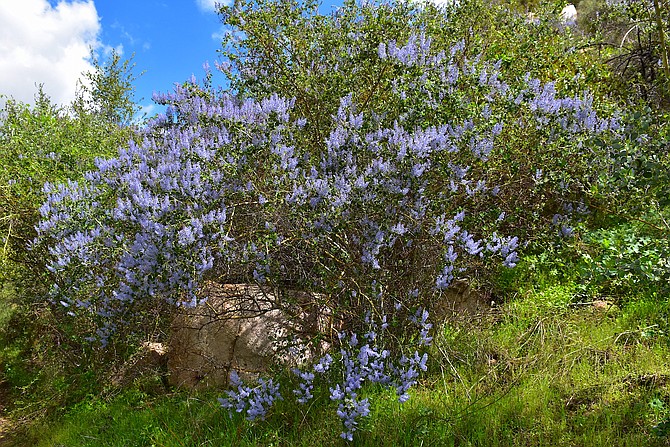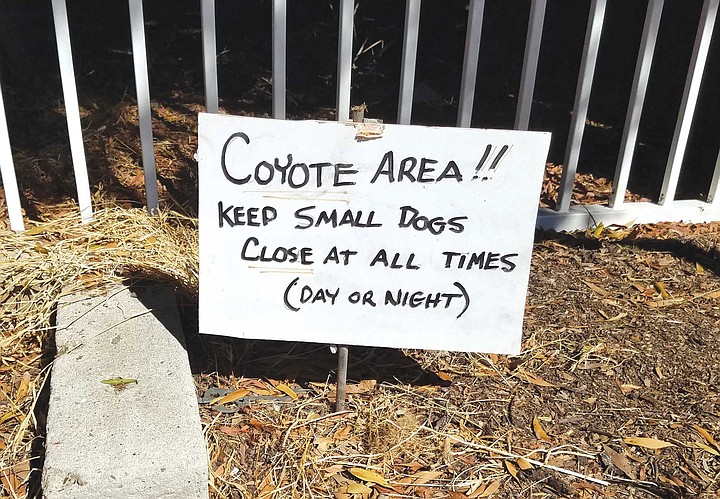 Facebook
Facebook
 X
X
 Instagram
Instagram
 TikTok
TikTok
 Youtube
Youtube

Rabbit and Rodent population is peaking in the canyons and hillsides of coastal San Diego County. In many neighborhoods, car headlights illuminate the rear ends of scampering cottontail rabbits making raids on succulent garden vegetation. On the fringes of suburbia, sleek coyotes are sometimes spotted slinking about in pursuit of rodents and rabbits, or easier-to-catch fare — house cats.

Wild Rose, a California native, is in bloom in San Diego County’s foothills and mountains. In moist, lowland areas and along small watercourses, wild rose shows off small, fluorescent-pink flowers. By June and July, the rose bloom will reach the Laguna and Palomar Mountains, where the plant grows in abundance in shady locales.
Wild Lilac (ceanothus) is currently blooming mostly at elevations higher than 4000 feet in San Diego County. Blossom colors range from pure white to various shades of blue or lavender. Some fine examples may be seen along the Noble Canyon and Big Laguna trails in the Laguna Mountain Recreation Area atop Mt. Laguna.
The gibbous Moon a day or two past first quarter is, I think, my favorite phase to observe. The terminator crosses all kinds of rich yet familiar lunar territory, and the Moon is highest in the convenient evening hours.
Did you know there are seven classical crater types? Before the space age, these categories spanned everything from the largest "walled plains" to the tiniest telescopic "crater pits." This stepwise classification reigned from 1837 until 1960.
Vega is the brightest star in the east-northeast after dark. Look upper left of it by 14° (about a fist and a half at arm's length) for Eltanin, the 2nd-magnitude nose of Draco the Dragon. Closer above and upper left of Eltanin are the three fainter stars forming the rest of Draco's stick-figure head, also called the Lozenge. Draco always points his nose to Vega, no matter how he's oriented.
The above comes from the Outdoors listings in the Reader compiled by Jerry Schad, author of Afoot & Afield in San Diego County. Schad died in 2011. Planet information from SkyandTelescope.org.


Rabbit and Rodent population is peaking in the canyons and hillsides of coastal San Diego County. In many neighborhoods, car headlights illuminate the rear ends of scampering cottontail rabbits making raids on succulent garden vegetation. On the fringes of suburbia, sleek coyotes are sometimes spotted slinking about in pursuit of rodents and rabbits, or easier-to-catch fare — house cats.

Wild Rose, a California native, is in bloom in San Diego County’s foothills and mountains. In moist, lowland areas and along small watercourses, wild rose shows off small, fluorescent-pink flowers. By June and July, the rose bloom will reach the Laguna and Palomar Mountains, where the plant grows in abundance in shady locales.
Wild Lilac (ceanothus) is currently blooming mostly at elevations higher than 4000 feet in San Diego County. Blossom colors range from pure white to various shades of blue or lavender. Some fine examples may be seen along the Noble Canyon and Big Laguna trails in the Laguna Mountain Recreation Area atop Mt. Laguna.
The gibbous Moon a day or two past first quarter is, I think, my favorite phase to observe. The terminator crosses all kinds of rich yet familiar lunar territory, and the Moon is highest in the convenient evening hours.
Did you know there are seven classical crater types? Before the space age, these categories spanned everything from the largest "walled plains" to the tiniest telescopic "crater pits." This stepwise classification reigned from 1837 until 1960.
Vega is the brightest star in the east-northeast after dark. Look upper left of it by 14° (about a fist and a half at arm's length) for Eltanin, the 2nd-magnitude nose of Draco the Dragon. Closer above and upper left of Eltanin are the three fainter stars forming the rest of Draco's stick-figure head, also called the Lozenge. Draco always points his nose to Vega, no matter how he's oriented.
The above comes from the Outdoors listings in the Reader compiled by Jerry Schad, author of Afoot & Afield in San Diego County. Schad died in 2011. Planet information from SkyandTelescope.org.
Comments